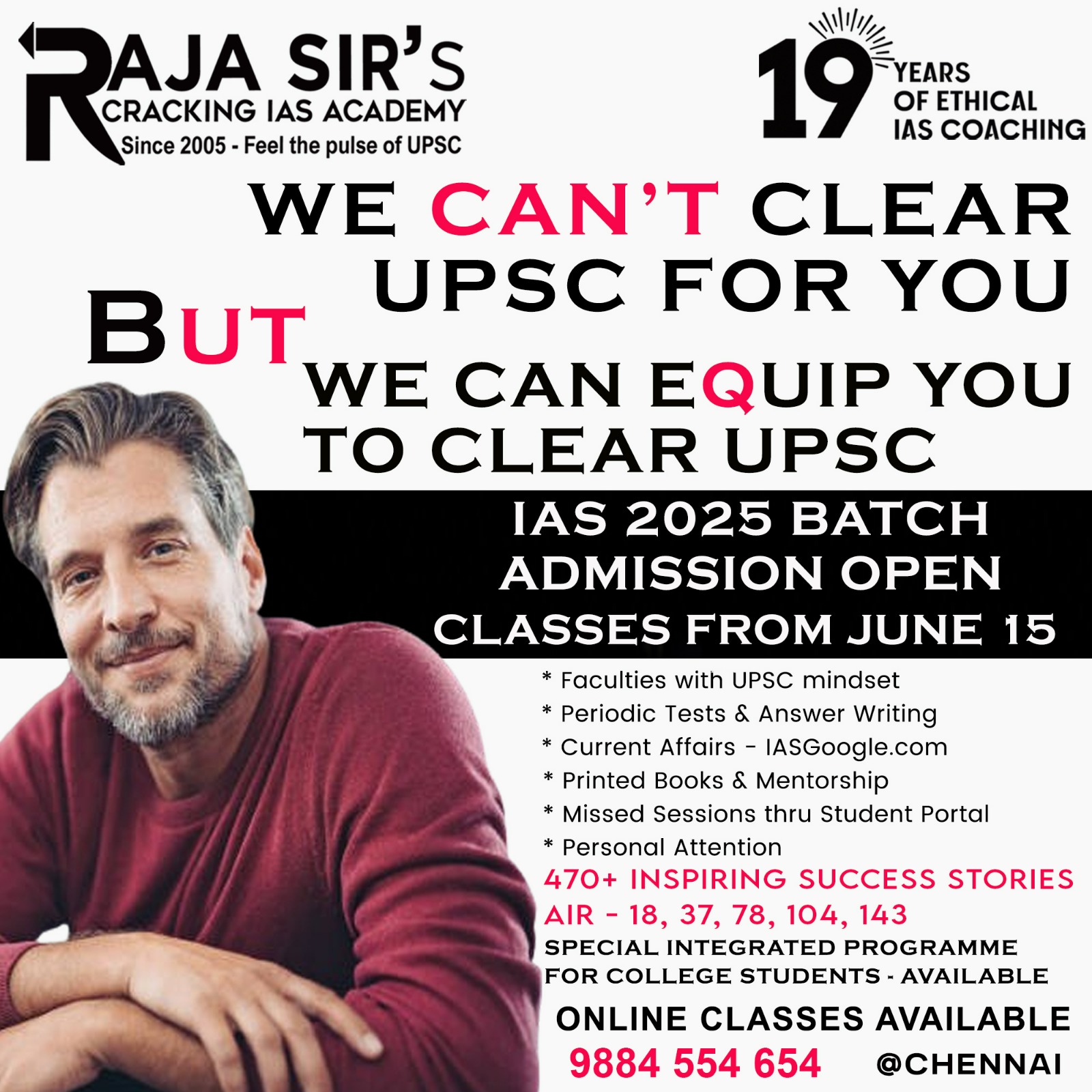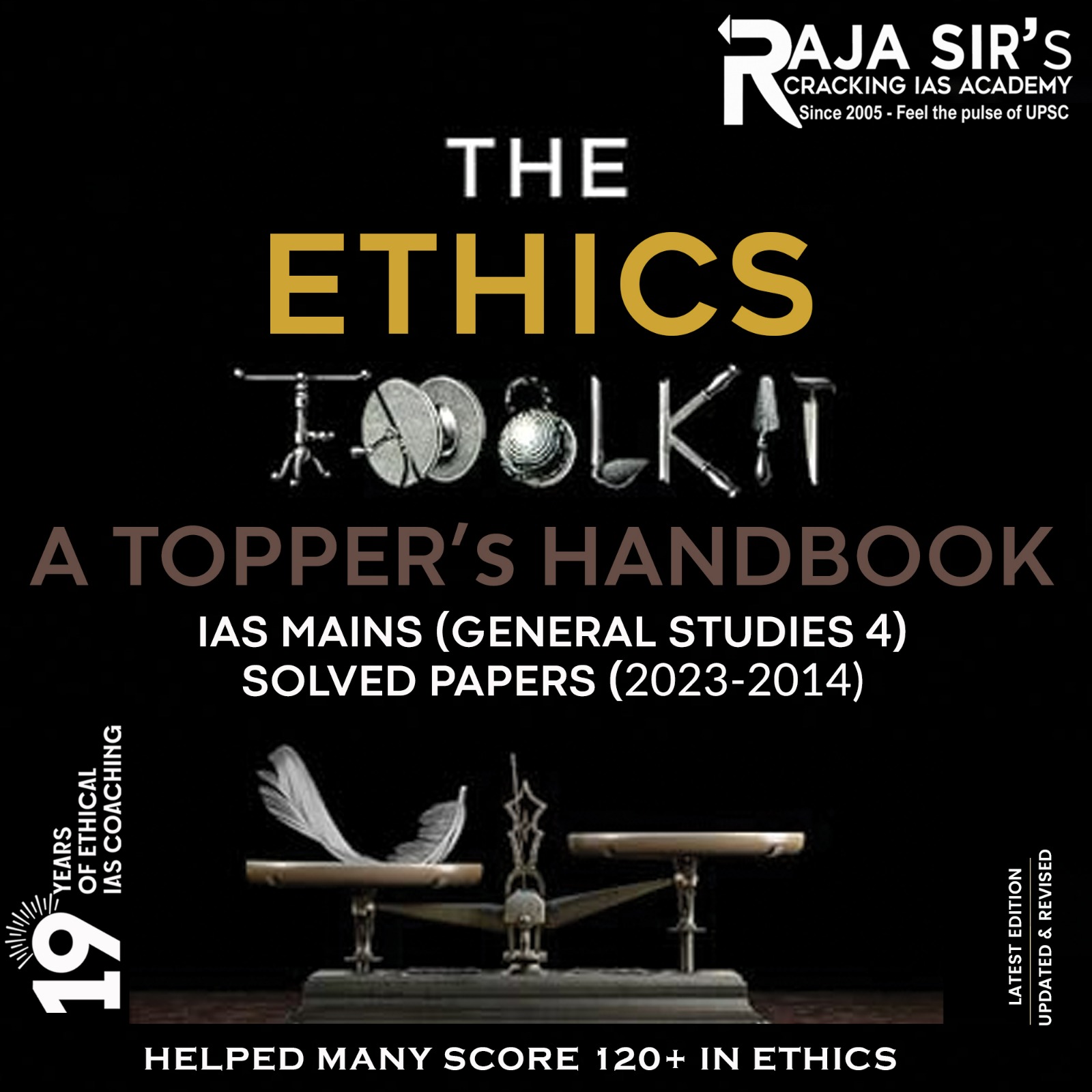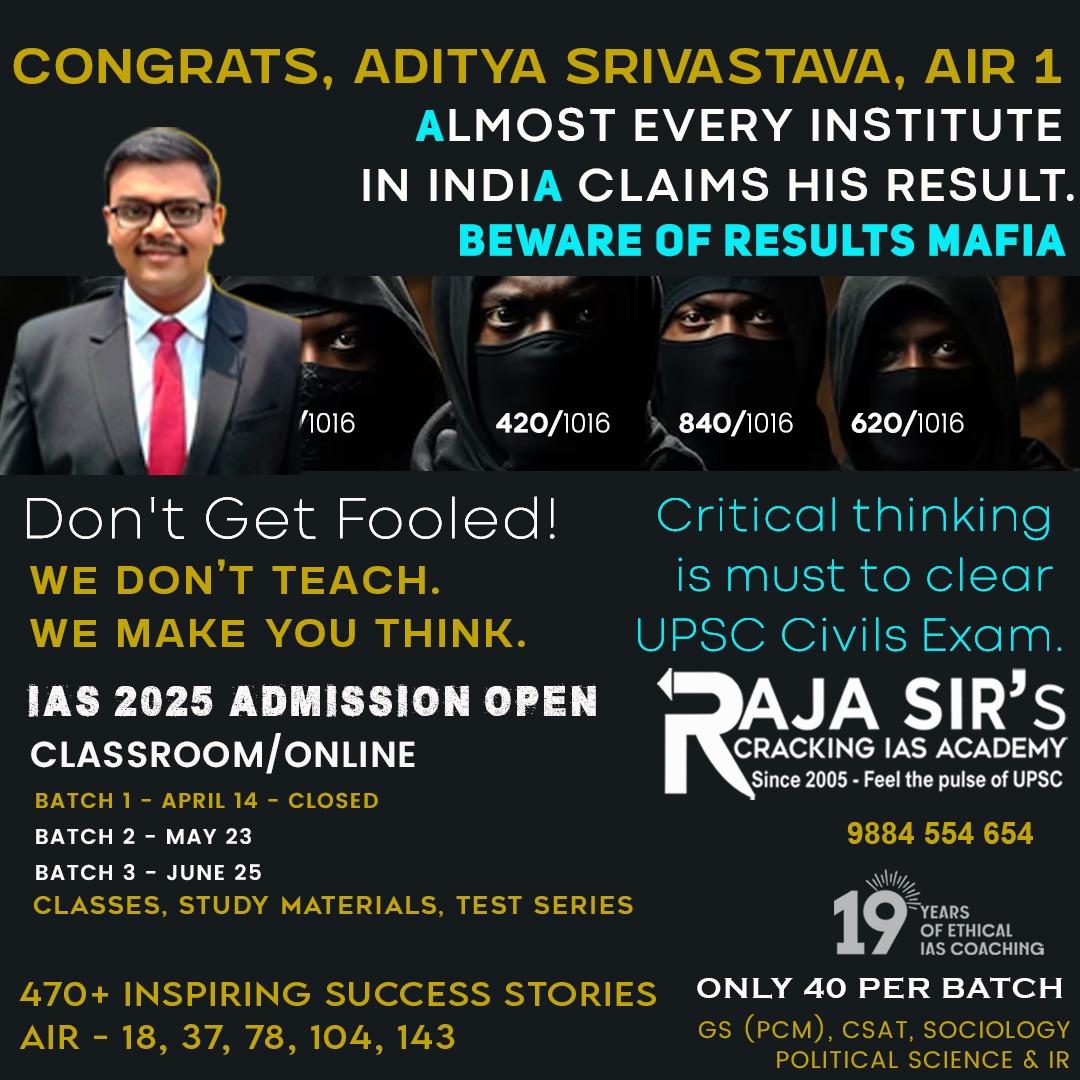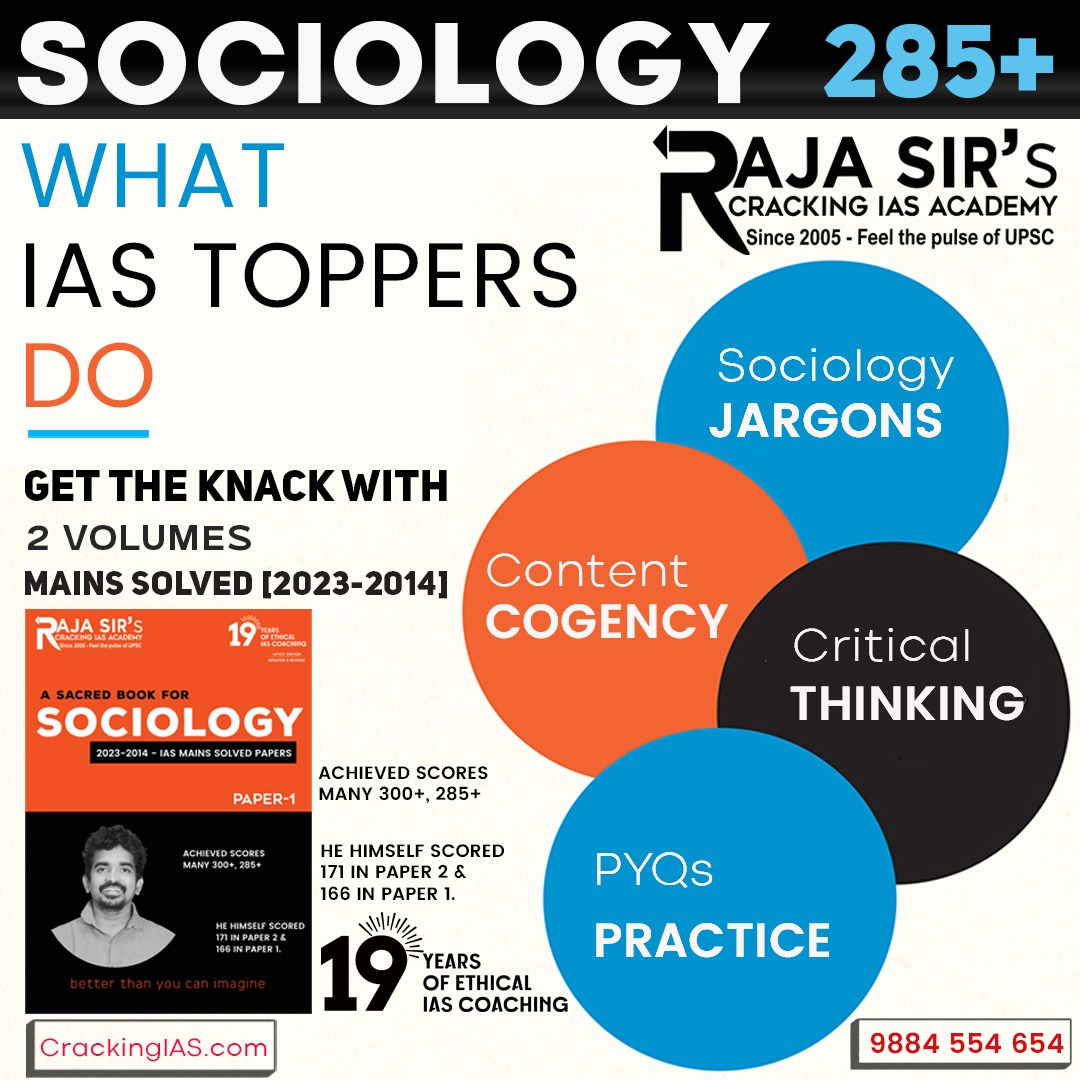- Home
- Prelims
- Mains
- Current Affairs
- Study Materials
- Test Series
Hit List Questions 42 - PPP 100 PRELIMS 2024 - 60
Questions & Explanations:
|
1. |
1. The earliest evidence of silver in India is found in the Chalcolithic cultures of Western India. 2. The specialty of the Chalcolithic culture was wheel made pottery mostly of red and orange colour. Which of the above statements is/are correct? (a) 1 only (b) 2 only (c) Both 1 and 2 (d) Neither 1 nor 2
|
|
||||||||||||
|
2. |
Arrange the following events of Akbar’s regime in their chronological order: 1. Abolition of Jizya 2. Construction of Ibadat Khana 3. Singing of Mahzar 4. Foundation of Din-i-Ilahi Select the correct answer from the codes given below: (a) 1, 2, 3, 4 (b) 2, 3, 4, 1 (c) 1, 3, 2, 4 (d) 3, 4, 1, 2
|
|
||||||||||||
|
3. |
Which Ruler of Vijaynagar had sent His ambassador To the Emperor of China? (a) Harihara I (b) Bukka I (c) Saluva Narasimha (d) Krishna Deva Raya
|
|
||||||||||||
|
4. |
i) It was constructed by Krishna Deva Raya. ii) It exemplifies Dravidian architectural style. iii) It has a Panchayat Hall kind of design with 12 pillars. How many of the above statements is/are correct w.r.t. “Virupaksha temple”?. (a) Only two (b) Only one (c) All the three (d) None of these
|
|
||||||||||||
|
5. |
Ashtapradhan was a Council of Ministers (a) In the Gupta administration (b) In the Chola administration (c) In the Vijayanagara administration (d) In the Maratha administration
|
|
||||||||||||
|
6. |
i) Ganigatti Temple ii) Krishna Temple iii) Lotus Mahal How many of the above is/are correct at Hampi?. (a) Only two (b) Only one (c) All the three (d) None of these
|
|
||||||||||||
|
7. |
Which one of the following is incorrect w.r.t. the Mughal Mansabdari System ? (a) There were 33 divisions. (b) All civil and military officers were given mansabs. (c) Horses were divided into five categories, while elephants were divided into six. (d) The terms Zat and Sawar were associated with this.
|
|
||||||||||||
|
8. |
Where was Pushpagiri University? (a) Tamilnadu (b) Teleangana (c) Odisha (d) Bihar
|
|
||||||||||||
|
9. |
Mandasor Stone inscription records the history of a guild of (a) goldsmiths (b) rathakaras (c) potters (d) silk weavers
|
|
||||||||||||
|
10. |
‘Pankodakasannirodhe’ was the Penalty in Mauryan administration, charged for (a) Filthy drinking water (b) Slushing the road (c) Throwing garbage (d) Stenching temples
|
|
||||||||||||
|
11. |
Nagorno Karabakh region in news is associated with (a) Nnatural gas regions of Iran. (b) Zone of conflict between Azerbaijan and Armenia. (c) Nuclear reactor in Ukraine. (d) Glacier in Antarctica.
|
|
||||||||||||
|
12. |
1. Net-zeromeans reaching a state where there are no emissions at all. 2. The net-zero goals were an outcome of 2015 Paris Agreement, the new global architecture to fight climate change. Which of the above statements is/are correct w.r.t. Net Zero Carbon Emission? (a) 1 only (b) 2 only (c) Both 1 and 2 (d) Neither 1 nor 2 o |
|
||||||||||||
|
13. |
1. Talle Wildlife Sanctuary 2. Eagle Nest Wildlife Sanctuary 3. Pakke Wildlife Sanctuary 4. Dibang Wildlife Sanctuary How many of the above is/are in Arunachal Pradesh? (a) Only two (b) Only one (c) All the four (d) Only three
|
|
||||||||||||
|
14. |
With reference to the invaders in ancient India, which one of the following is the correct chronological order? (a) Greeks-Sakas-Kushanas (b) Greeks-Kushanas-Sakas (c) Sakas-Greeks-Kushanas (d) Sakas-Kushanas-Greeks
|
|
||||||||||||
|
15. |
Consider the following statements w.r.t. Bar Council of India. 1. It is a statutory body created by Parliament under the Advocates Act, 1961. 2. It performs the advisory function by prescribing standards of professional conduct and etiquette and by exercising disciplinary jurisdiction over the bar. (a) Only 1 is true (b) Only 2 is true (c) Both 1 and 2 are true (d) Neither 1 nor 2 is true
|
|
||||||||||||
|
16. |
Consider the following statements w.r.t. Raja Bhoj. 1. He was a king of Chandela dynasty. 2. He founded a center for Sanskrit studies in Dhar. 3. Dasabala was his court poet. 4. Modasa copper plates record his reign. (a) 1, 2 and 3 (b) 1, 3 and 4 (c) 2, 3 and 4 (d) 1, 2 and 4
|
|
||||||||||||
|
17. |
1. Tamilnadu 2. Maharashtra 3. Andhra Pradesh 4. Telangana 5. Karnataka Polavaram project envisages transfer of 80TMC of surplus Godavari water to river Krishna which will be shared between (a) 1, 2. 3 and 4 only (b) 1, 3, 4 and 5 only (c) 2. 3 and 5 only (d) 2, 3, 4 and 5
|
|
||||||||||||
|
18. |
The Vessantara Jataka is one of the most popular Apadanas of Theravada Buddhism. These Jatakas are carved on (a) Kesaria Stupa (b) Sanchi Stupa (c) Dro-Dul Chorten Stupa (d) Dhamekh Stupa
|
|
||||||||||||
|
19. |
Which among the following ports was called Babul Mecca (Gate of Mecca) during the Mughal Period?. (a) Calicut (b) Bharuch (c) Cambay (d) Surat
|
|
||||||||||||
|
20. |
The structural elements of a Buddhist Stupa from the base of a stupa to its height in that order is (a) Hermika - Medhi - Anda- Chhatri (b) Anda - Hermika - Chhatri - Medhi (c) Medhi - Hermika - chhatri - Anda (d) Medhi - Anda - Harmika- Chhatri
|
|
||||||||||||
|
21. |
Dabhol and Chaul were (a) principal ports of Bahmani kingdom. (b) buddhist learning sites patronized by Satavahanas. (c) musical instruments introduced by Tansen. (d) ijara centers under Delhi Sultanates
|
|
||||||||||||
|
22. |
1. Fa-Hien 2. I-Tsing 3. Megasthenes 4. Hieun-Tsang The correct chronological sequence of their visits are: (a) 3, 1, 2, 4 (b) 3, 1, 4, 2 (c) 3, 2, 1, 4 (d) 3, 2, 4, 1
|
|
||||||||||||
|
23. |
Match List i with List II.
(a) A-3, B-4, C-5, D-2 (b) A-3, B-4, C-2, D-5 (c) A-5, B-3, C-4, D-1 (d) A-1, B-3, C-5, D-2
|
|
||||||||||||
|
24. |
Two harappan settelments which were specialized centers for making shell objects (a) Lothal and Kalibanga (b) Kalibanga and Mohenjodaro (c) Nageshwar and Balakot (d) Manda and Lothal
|
|
||||||||||||
|
25. |
Consider the following statements: 1. Rabindranath Tagore to capture the full import of the outrage at Jallianwala Bagh. renounced the knighthood conferred on him. 2. The Anarchical and Revolutionary Crimes Act came into force a month before the massacre in Jallianwala Bagh. Which of the above statements is/are correct? (a) 1 only (b) 2 only (c) Both 1 and 2 (d) Neither 1 nor 2
|
|
|
|
EXPLANATIONS
|
|
|
1. |
The Harappans were familiar with silver and evidence of its correct use has been discovered from Mohan Jodaro and Harappa. They obtained silver from the mines of Zawar and Ajmer in Rajasthan, as well as from Afghanistan and Iran for Harrapa and Mohenjodaro. Chalcolithic Culture: The end of the Neolithic period saw the use of metals. Several cultures were based on the use of copper and stone implements. § Such a culture is called Chalcolithic and as the name indicates, during the Chalcolithic (Chalco = Copper and Lithic = Stone) period, both metal and stone were utilised for the manufacture of the equipment in day-to-day life. § The Chalcolithic cultures followed the Bronze Age Harappa culture. § It spanned around 2500 BC to 700 BC. § Salient Features: The Chalcolithic culture of a region was defined according to certain salient features seen in ceramics and other cultural equipment like copper artefacts, beads of semi-precious stones, stone tools and terracotta figurines. Characteristics: § Rural Settlements: The people were mostly rural and lived near hills and rivers. § The people of Chalcolithic Age survived on hunting, fishing, and farming § Regional Differences: Regional differences in social structure, cereals and pottery become visible. § Migration: Migration and diffusion of population groups were often cited as causes for the origin of different cultures within the Chalcolithic period. § First Metal Age of India: Since this was the first metal age, copper and its alloy bronze which melt at low temperature were used for the manufacture of various objects during this period. § Art and Craft: The specialty of the Chalcolithic culture was wheel made pottery mostly of red and orange colour. § Different types of pottery were used by the people of the Chalcolithic phase. The Black-and-Red pottery among them was quite common. § The Ochre-Coloured Pottery(OCP) was also in use. |
B |
|
2. |
Akbar abolished Jizya in 1564. The construction of Ibadat Khana occurred in 1575 whose main purpose was to facilitate philosophical and theological discussions. The declaration of Mahzarnama was held in 1579 which was prepared by Shaikh Mubarak, the father of Abul Fazl. Akbar founded Din-i-Illahi in 1582 for religious harmony. |
A |
|
3. |
Bukka I:
Krishnadevaraya:
Devaraya I:
Harihara II:
|
B |
|
4. |
https://iasgoogle.com/editorial_detail/temples-of-badami-chalukyas The temple was built on the orders of Lokamahadevi, Vikramaditya II''s senior queen, to commemorate his victory over the Pallavas. It shares many similarities with Kanchi''s Kailasanatha temple. It is the largest monument of Chalukyas of Badami. This was later improvised in the Vijayanagar empire. This temple is special because it has a Panchayat Hall kind of design with 12 pillars. This was the earliest experiment for a pillar-based structure in temple architecture. It is located in Hampi and, is dedicated to Lord Shiva. The distance from Bangalore to Hampi is about 350 km. Hampi is a temple town in South India and is acknowledged as one of the World Heritage Sites of UNESCO. This temple was constructed in Lakkana Dandesha’s assistance who was a commander under King Deva Raya II. The mature phase of Badami Chalukyan architecture includes the structural temples at Pattadakal, which were built in the 8th century and are now a UNESCO World Heritage Site. There are ten temples at Pattadakal, six in southern Dravida style and four in the northern Nagara style. Well known among these are the Sangamesvara Temple, the famous Virupaksha Temple of Karnataka which contains a lot of representations from the Mahabharata, and the Mallikarjuna Temple built in the southern style. |
A |
|
5. |
''Ashtapradhan'' was a council of eight ministers constituted by Shivaji in Maratha administration. The eight ministers were 1. Peshwa, 2. Pandit Rao, 3. Sumant, 4. Amatya, 5. Mantri, 6. Sachiv, 7. Senapati, 8. Nyayadhish. (i) Peshwa- Prime Minister of King (ii) Amatya or Mazumdar- Finance and Revenue Minister (iii) Wakianavis/Mantri- Interior minister, managing internal aff airs, especially intelligence and espionage. Indian History General Studies (iv) Sachiv/Surnavis-Responsible for all correspondence. (v) Sumant/Dabir- Foreign Minister (vi) Senapati/Sar-i-Naubat - Maintainance of appointments, organization and food supply of military. (vii) Pandit Rao- High Priest (viii) Nyaydhish- Chief Justice |
d |
|
6. |
C |
|
|
7. |
https://iasgoogle.com/editorial_detail/what-is-mansabdari-system |
C |
|
8. |
ü C |
|
|
9. |
The Mandasor Stone inscription is an ancient inscription found in the city of Mandasor in Madhya Pradesh, India. It is believed to date back to the 5th century CE and is written in Sanskrit. The inscription records the history of a guild of silk weavers, providing valuable insight into the economic and social history of the region. It tells us about the existence of a guild of silk weavers, which indicates that silk production was an important industry in the area. The inscription also provides us with information about the social organization of the guild, including its membership and leadership structure.
|
D |
|
10. |
Megasthenese divided Mauryan society into seven categories which are as follows : (1) Philosophers (2) Farmers (3) Herdsmen (4) Artisans (5) Military (Soldier) (6) Overseers or Spies (7) Assessors. Megasthenese does not mention slavery in India. According to him, no one could marry outside his caste, and no one could take to an occupation other than the one fi xed for his caste. *Mauryan emperors played a major role in the development of culture, art and literature. Chandragupta’s empire spread over from Iran in the north-west to present north Karnataka in the south. “Bhaga” and “Bali” were the sources of revenue in ancient India. According to Arthashastra, King was the owner of the land. He had a share in produce from the land. This tax was known as ‘Bhaga’ whereas ‘Bali was also a source of revenue. *Agronomoi was known as district offi cers. Shulkadhyaksha used to collect various trade and service tax and Akradhyaksha controlled mines. The maintenance of crown land was done by Sitadhyaksha in Mauryan period. Revenue collected through this tax was known as ''Sita''. *Revenue collection was regulated by Samaharta in Mauryan ministerial council. *Antapal looked after border forts while the Pradeshtha was an administrator of commissionaries. *Mauryan officer Pautavadhyaksha was in charge of weights and measures while Panyadhyaksha was the in charge of the Commerce Department, and Sunadhyaksha was the chief of the slaughterhouse. ‘Pankodakasannirodhe’ was the penalty in Mauryan administration for throwing dirt or causing mud and water to collect on the roads. *The Arthashastra mentions two types of courts: *Dharmasthiya which is analogous with modern civil courts and Kantakshodhana which is analogous to modern criminal courts. |
B |
|
11. |
B |
|
|
12. |
Net-zero, which is also referred to as carbon-neutrality, does not mean that a country would bring down its emissions to zero. The net-zero goals do not figure in the 2015 Paris Agreement, the new global architecture to fight climate change. |
D |
|
13. |
Protected areas in Arunachal Pradesh Talle Wildlife Sanctuary (Protected area) Dihang Dibang Biosphere Reserve Eagle Nest Wildlife Sanctuar Namdapha Tiger Reserve Mouling National Park Sessa Orchid Sanctuary Pakke Wildlife Sanctuary Dibang Wildlife Sanctuary Kamlang Wildlife Sanctuary Itanagar Wildlife Sanctuary |
C |
|
14. |
|
A |
|
15. |
Bar Council of India
|
A |
|
16. |
https://iasgoogle.com/editorial_detail/paramaras-chandelas-kalachuris-amp-sisodiyas |
C |
|
17. |
Polavaram Project: It is a major multi-purpose irrigation project being constructed on the Godavari River, and spread across three states – Andhra, Odisha and Chhattisgarh. The project implements Godavari-Krishna link under Interlinking of rivers project. The project envisages transfer of 80TMC of surplus Godavari water to river Krishna which will be shared between Andhra Pradesh, Karnataka and Maharashtra in proportion of 45 TMC by AP and 35 TMC by Karnataka and Maharashtra as per the decision of the GWDT award. |
C |
|
18. |
· The Vessantara Jataka is a story from the Jataka tales, which are a collection of stories about the previous lives of the Buddha. · The Jataka tales are an important part of Buddhist literature and are widely revered in Theravada Buddhism. · The Vessantara Jataka is considered one of the most popular and significant Jataka tales. · It tells the story of Prince Vessantara, who is known for his extraordinary generosity and giving away his possessions, including his children and wife, to those in need. · The story is seen as a moral lesson on the virtues of selflessness and compassion. · The Jataka tales, including the Vessantara Jataka, are often depicted in art and sculpture, particularly in Buddhist stupas. |
B |
|
19. |
During the Mughal period, pilgrims used to visit Mecca for Haj from Surat. Hence, Surat was known as ‘Meccai dwar,’ ‘Babul Mecca’ (Gate of Mecca) and ‘Meccabari.’ |
D |
|
20. |
D |
|
|
21. |
The Bahmani Kingdom was a medieval Indian state that existed from 1347 to 1527 CE. It was one of the major Muslim states in the Deccan region of India. The kingdom had a strong maritime trade network, and its ports played a crucial role in facilitating trade and commerce. Chaul: Chaul, also known as Revdanda, was an important port town located on the west coast of India in present-day Maharashtra. It was strategically located and served as a major trading center during the Bahmani Kingdom. Chaul was known for its shipbuilding industry and had trade connections with various regions, including the Persian Gulf, Red Sea, and East Africa. Cabho: Cabho, also known as Kapu, was another significant port town situated on the west coast of India, in present-day Karnataka. It was a thriving commercial center and served as a major port during the Bahmani Kingdom. Cabho had trade links with foreign regions such as Arabia, Persia, and East Africa. The port was renowned for its trade in spices, textiles, and precious stones. Calicut: Calicut, now known as Kozhikode, was a prominent port city on the Malabar Coast of present-day Kerala. It was a flourishing trading center during the Bahmani Kingdom and played a crucial role in the maritime trade network of the time. Calicut had extensive trade connections with various regions, including the Middle East, China, and Europe. The port was famous for its trade in spices, especially pepper, which was highly sought after in international markets. The Bahmani Kingdom had a strong maritime trade network, and its principal ports played a crucial role in facilitating trade and commerce. Chaul, Cabho, and Calicut were among the major ports of the kingdom, with each port having its own unique trade connections and specialties. These ports were instrumental in establishing the Bahmani Kingdom as a major commercial power in medieval India.
|
A |
|
22. |
Megasthenes (302–298 BC):
Hiuen-Tsang (630–645 AD):
I-tsing (671–695 AD):
Nicolo Conti (1420-1421 AD):
Fa-Hien (405–411 AD):
|
B |
|
23. |
Varahamihira - Brihat Samhita Vishakhadatta – Devi Chandraguptam Sudraka - Mrichchha Katikam Bilhana -Vikramankadev Charita Prabandha Chintamani was composed by Merutungacharya. |
B |
|
24. |
Nageshwar and Balakot areas were famous for shells. Lothal which was near sources of carnelian (from Bharuch in Gujarat), steatite (from south Rajasthan and north Gujarat) and metal (from Rajasthan). Another strategy for procuring raw materials may have been to send expeditions to areas such as the Khetri region of Rajasthan (for copper) and south India (for gold). Sites such as Shortughai, in far-off Afghanistan, near the best source of lapis lazuli, a blue stone that was apparently very highly valued. |
C |
|
25. |
Jallianwala Bagh’s importance lies not in the numbers killed but in what preceded it and in what followed. The Anarchical and Revolutionary Crimes Act of 1919, better known as the Rowlatt Act, came into force a month before the massacre in Jallianwala Bagh. It shocked most Indians who had expected to be rewarded, not punished, for willingly fighting alongside the British in the First World War. |
C |









 Latest News
Latest News





 General Studies
General Studies